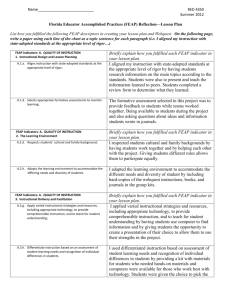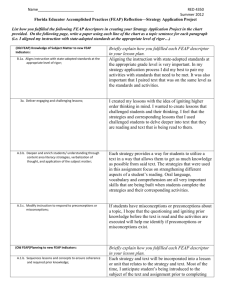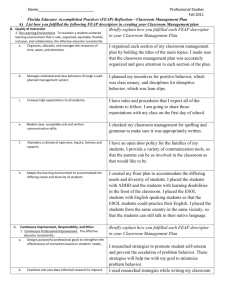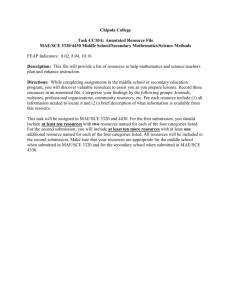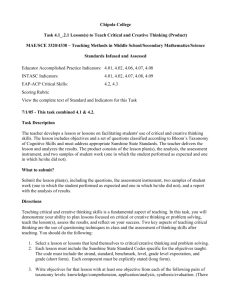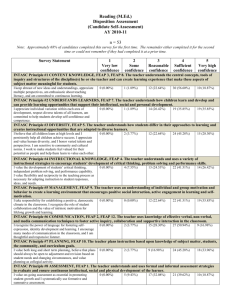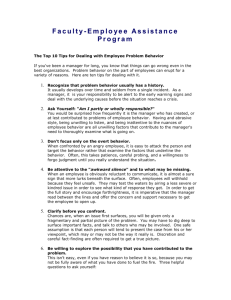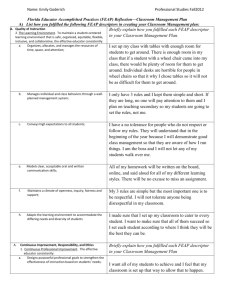Key Assignment/Critical Task Curriculum Alignment Evidence
advertisement
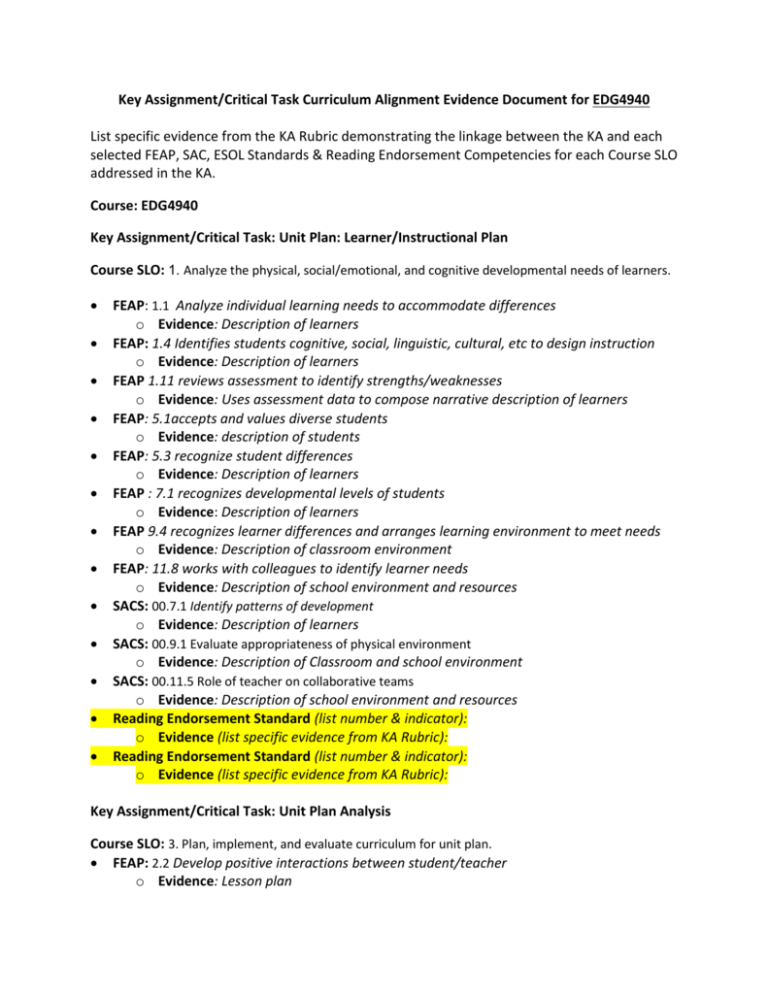
Key Assignment/Critical Task Curriculum Alignment Evidence Document for EDG4940 List specific evidence from the KA Rubric demonstrating the linkage between the KA and each selected FEAP, SAC, ESOL Standards & Reading Endorsement Competencies for each Course SLO addressed in the KA. Course: EDG4940 Key Assignment/Critical Task: Unit Plan: Learner/Instructional Plan Course SLO: 1. Analyze the physical, social/emotional, and cognitive developmental needs of learners. FEAP: 1.1 Analyze individual learning needs to accommodate differences o Evidence: Description of learners FEAP: 1.4 Identifies students cognitive, social, linguistic, cultural, etc to design instruction o Evidence: Description of learners FEAP 1.11 reviews assessment to identify strengths/weaknesses o Evidence: Uses assessment data to compose narrative description of learners FEAP: 5.1accepts and values diverse students o Evidence: description of students FEAP: 5.3 recognize student differences o Evidence: Description of learners FEAP : 7.1 recognizes developmental levels of students o Evidence: Description of learners FEAP 9.4 recognizes learner differences and arranges learning environment to meet needs o Evidence: Description of classroom environment FEAP: 11.8 works with colleagues to identify learner needs o Evidence: Description of school environment and resources SACS: 00.7.1 Identify patterns of development o Evidence: Description of learners SACS: 00.9.1 Evaluate appropriateness of physical environment o Evidence: Description of Classroom and school environment SACS: 00.11.5 Role of teacher on collaborative teams o Evidence: Description of school environment and resources Reading Endorsement Standard (list number & indicator): o Evidence (list specific evidence from KA Rubric): Reading Endorsement Standard (list number & indicator): o Evidence (list specific evidence from KA Rubric): Key Assignment/Critical Task: Unit Plan Analysis Course SLO: 3. Plan, implement, and evaluate curriculum for unit plan. FEAP: 2.2 Develop positive interactions between student/teacher o Evidence: Lesson plan FEAP 2.5 Communicates high expectations o Evidence: Lesson plan implementation FEAP: 2.6 acquires interaction routines (guided practice, independent practice, cooperative learning) o Evidence: Lesson Plan FEAP : 2.7 Provides opportunity for students to learn from each other o Evidence: Lesson plan, Guided practice FEAP: 4.4 Poses problems, dilemmas, and questions o Evidence: Lesson plan FEAP 5.4 Diversity among students o Evidence: DI component of lesson plan FEAP: 5.5 strategies to teach all students o Evidence: DI component of Lesson Plan FEAP: 7.2 Links old knowledge to new knowledge o Evidence: lesson introduction linking previous knowledge to new knowledge/skills FEAP: 7.5 varies activities to accommodate different learning needs o Evidence: DI component of Lesson Plan FEAP : 8.1 Communicates subject matter so that students can learn o Evidence: Lesson implementation FEAP: 8.2 Increases subject matter o Evidence: Lesson plan FEAP 9.4 Arranges learning environment to meet needs o Evidence: Lesson implementation FEAP: 9.10 implements instructional strategies o Evidence: Implements Lesson Plan FEAP: 9.11 Arranges and manages to environment o Evidence: lesson implementation FEAP: 10.1 Identifies student performance outcomes o Evidence: NGSSS on Lesson Plan FEAP : 10.2 Plans and Implements lessons based on outcomes o Evidence: NGSSS and learning outcomes of Lesson Plan FEAP: 10.3 activities that promote high standards o Evidence: Lesson plan FEAP 10.9 uses visual and physical environment for teaching o Evidence: Lesson implementation FEAP: 10.13 Develop concepts through variety of methods o Evidence: Implements Lesson Plan SACS: 00.4.1 use variety of strategies for critical thinking o Evidence: Lesson plan SACS: 00.4.2 use variety of strategies for creative thinking o Evidence: Lesson plan SACS: 00.8.1 Effective text reading skills o Evidence: Reading Lesson plans SACS: 00.8.3 Effective comprehension skills o Evidence: Reading lesson plans SACS: 00.8.6 Differentiating reading instruction based on data o Evidence: Di component of lesson with daily assessments SACS: 00.10.3 Identify materials based on needs and performance levels o Evidence: lesson plans Reading Endorsement Standard (list number & indicator): o Evidence (list specific evidence from KA Rubric): Reading Endorsement Standard (list number & indicator): Key Assignment/Critical Task: Unit Plan Analysis Course SLO: 4. Design specific differentiated learning activities and techniques for ELL, Exceptional Students, and non-traditional learners. 10.6, FEAP: 2.2 Develop positive interactions between student/teacher o Evidence: Lesson plan FEAP 2.3 Varies communication o Evidence: DI lesson plan component FEAP: 2.4 encourages students o Evidence: Lesson Plan FEAP : 3.6 Reflects respect for diversity o Evidence: DI component of Lesson plan FEAP: 4.6 varies instructional process based on student response o Evidence: DI component of Lesson plan FEAP: 5.4 Diversity among students o Evidence: DI component of lesson plan FEAP: 5.5 strategies to teach all students o Evidence: DI component of Lesson Plan FEAP: 6.1 makes reasonable effort to protect students o Evidence: Di activities FEAP: 7.4 Communicate effectively with students o Evidence: Di activities FEAP: 7.5 varies activities to accommodate different learning needs o Evidence: DI component of Lesson Plan FEAP 9.4 Arranges learning environment to meet needs o Evidence: Lesson implementation FEAP: 9.8 Respects student’s right to use native language o Evidence: Di activities FEAP: 9.10 implements instructional strategies o Evidence: Implements Lesson Plan FEAP: 10.6 Plans activities that use a variety of support materials o Evidence: DI components of Lesson Plan SACS: 00.2.4 effective communication skills o Evidence: DI activities in Lesson plan SACS: 00.4.2 use variety of strategies for creative thinking o Evidence: Lesson plan SACS: 00.5.1 positive environment for all o Evidence: DI activities in lesson plan SACS: 00.7.3 activities to accommodate levels of learning o Evidence: : DI activities in lesson plan SACS: 00.8.6 Differentiating reading instruction based on data o Evidence: Di component of lesson with daily assessments SACS: 00.14.3 activities that build on abilities and self worth. o Evidence: : DI activities in lesson plan Reading Endorsement Standard (list number & indicator): o Evidence (list specific evidence from KA Rubric): Reading Endorsement Standard (list number & indicator): NOTE: Continue for all Course SLOs addressed in the Key Assignment
